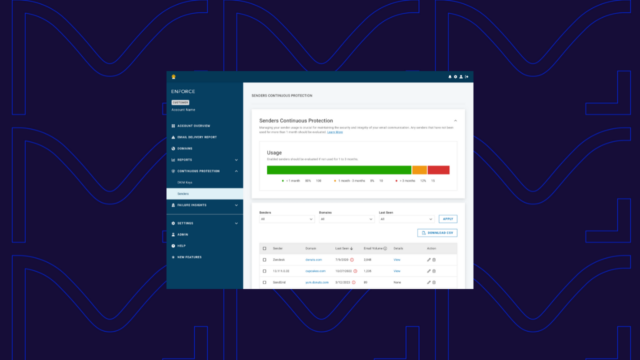Watering hole attacks are a cybersecurity threat lurking silently beneath the surface, often overlooked yet increasingly prevalent. This type of cyber assault, like a predator waiting at a watering hole to ambush its prey, involves infiltrating websites frequently visited by targeted individuals or groups. The attackers subtly compromise these trusted sites to distribute malware or gain unauthorized access to the victims’ systems.
As cybercriminals evolve in their sophistication, so do their methods of exploitation. These attacks are no longer just the woes of large corporations or government entities—they have broadened their reach to attack small businesses and even individual users.
Since email is often the starting point for many cyber threats (including malware dissemination through watering hole attacks), a robust email authentication framework is crucial to protecting your brand and its customers. This article will walk you through everything you need to know about watering hole attacks to better prevent them and safeguard your business.
What is a watering hole attack?
A watering hole attack is a cyber attack that targets specific groups by compromising websites they commonly visit, such as industry blogs, vendor portals, or specialized forums.
One of the earliest and most famous watering hole attacks (dubbed Operation Aurora) targeted high-profile companies like Google and Adobe in 2010. Attackers used a zero-day vulnerability in Internet Explorer to compromise corporate networks.
Then, there was the 2014 Forbes.com incident, where the Forbes website was compromised to target financial services and defense sectors by exploiting Adobe Flash and Internet Explorer vulnerabilities.
Watering hole attacks exemplify the sophistication and targeted nature of modern cyber threats. They demonstrate that attackers are willing to play a long game, investing time in reconnaissance and patiently waiting for the right moment to strike. This method’s success hinges on the trust users have in the compromised websites, making it a particularly deceptive form of cyber attack.
How attackers target victims
Understanding how these attacks work can give you the know-how to better protect your brand. Let’s look at the step-by-step process bad actors typically follow to execute a watering hole attack:
1. Initial reconnaissance
During this stage, attackers meticulously identify their intended targets, which are typically organizations or individuals within a specific industry or sector. This process involves extensive research to understand the target group’s online behavior, including the websites they frequently visit for information, communication, or services.
Once attackers understand your behaviors and habits, they pinpoint the most effective ‘watering holes.’ This careful selection process ensures that the subsequent stages of the attack are tailored to the specific characteristics and vulnerabilities of the chosen group.
2. Compromise the website
The attacker aims to find and exploit vulnerabilities, allowing them to inject malicious code into these sites. This could involve a variety of tactics, such as taking advantage of outdated software, weak administrative passwords, or known security loopholes that haven’t been patched.
The sophistication of this stage can vary, with some attackers using advanced techniques to exploit zero-day vulnerabilities, while others might opt for more straightforward methods like brute-force attacks. The compromised website becomes a disguised trap, waiting for unsuspecting visitors to trigger the malicious code.
3. Trigger the trap
When targeted users visit the compromised website, they encounter this hidden trap. Unknown to them, visiting the site triggers the execution of the malicious code. Some may install malware on the visitor’s device, a few might aim to steal login credentials, and others redirect the user to a completely different site that hosts further malicious content.
This phase is particularly insidious because it exploits users’ trust in legitimate websites.
4. Exploit the system
Now that attackers have gained the sensitive information they want, they can exploit it. This might involve data theft, where sensitive personal or corporate information is extracted for financial gain or espionage. Attackers might also use their access to launch additional attacks, either on the same targets or using the compromised systems as a springboard to reach new ones.
In some scenarios, they establish a persistent presence within the network, allowing them ongoing access to monitor, steal, or manipulate data over an extended period.
Top preventive strategies for organizations
While companies can clean up and repair the aftermath of watering hole attacks, it’s incredibly costly and harmful to your brand’s reputation. Prevention is always better than cure, and (fortunately) there are plenty of ways to safeguard your domains to thwart cyber attacks.
You’ll need a multi-layered defense strategy to protect yourself from all angles. Here are the key preventive measures that can significantly reduce the risk and impact of these sophisticated cyber threats.
DMARC for email authentication
Use Domain-based Message Authentication, Reporting, and Conformance (DMARC) as a cornerstone of your email authentication strategy. DMARC ensures that emails from your domain are authenticated, significantly reducing the risk of phishing attacks (often a precursor to watering hole attacks).
Implementing DMARC gives you greater visibility into the emails being sent from your domain, including potential fraudulent activity. This allows for more effective monitoring and control of your email communications.
Regular security audits and monitoring
Regularly conduct comprehensive security audits of your IT infrastructure. This should include thoroughly examining your web assets to identify and patch vulnerabilities.
Implement real-time monitoring for your network and websites. Use tools that can detect unusual activities or changes in website code, which could indicate a compromise.
Employee awareness and training
Conduct regular cybersecurity training for employees. Educate them about the latest threats, including watering hole attacks, and teach them how to recognize and respond to suspicious activities.
Use simulated phishing exercises to test employees’ awareness and readiness. This helps in identifying areas where additional training might be needed.
Secure web browsing practices
Implement and require the use of secure web browsing tools, such as trusted browser extensions that detect and block malicious websites. Encourage using Virtual Private Networks (VPNs), especially when employees access corporate resources remotely.
Vendor and third-party management
Regularly evaluate the security posture of third-party vendors and partners, especially those with access to your network or data. Ensure secure and encrypted channels for data sharing with external entities to minimize the risk of data interception or leakage.
FAQs about watering hole attacks
1. How do I know if my organization is at risk of a watering hole attack?
Any organization can be at risk, especially those without robust cybersecurity measures. Your organization could be a target if your employees frequently visit industry-specific websites and forums or use common online tools.
2. Can regular antivirus software protect against watering hole attacks?
While antivirus software is a critical component of cybersecurity alone, it may not be sufficient to protect against watering hole attacks, especially if the malware used is sophisticated or previously unknown.
3. What role does email play in preventing watering hole attacks?
Authentication, particularly using DMARC for email authentication, plays a crucial role. It helps prevent phishing emails, which are often used to direct users to compromised watering hole sites.
4. How can my organization prevent watering hole attacks?
Implement a comprehensive cybersecurity strategy that includes regular security audits, employee training, secure web browsing practices, vigilant third-party management, and a robust email authentication system, such as Valimail.
Protect your brand with DMARC
Understanding the nuances of watering hole attacks and implementing a multi-layered defense strategy is essential for organizations seeking to safeguard their data and networks. Valimail Monitor offers a powerful starting point.
Monitor provides visibility into your email ecosystem to help you identify and address vulnerabilities in your domain’s email authentication practices. This can help prevent watering hole attacks from spreading and stops a wide range of other email-based threats.
Get started with Monitor for free to gain visibility into the global traffic being sent on behalf of your primary and subdomains.



